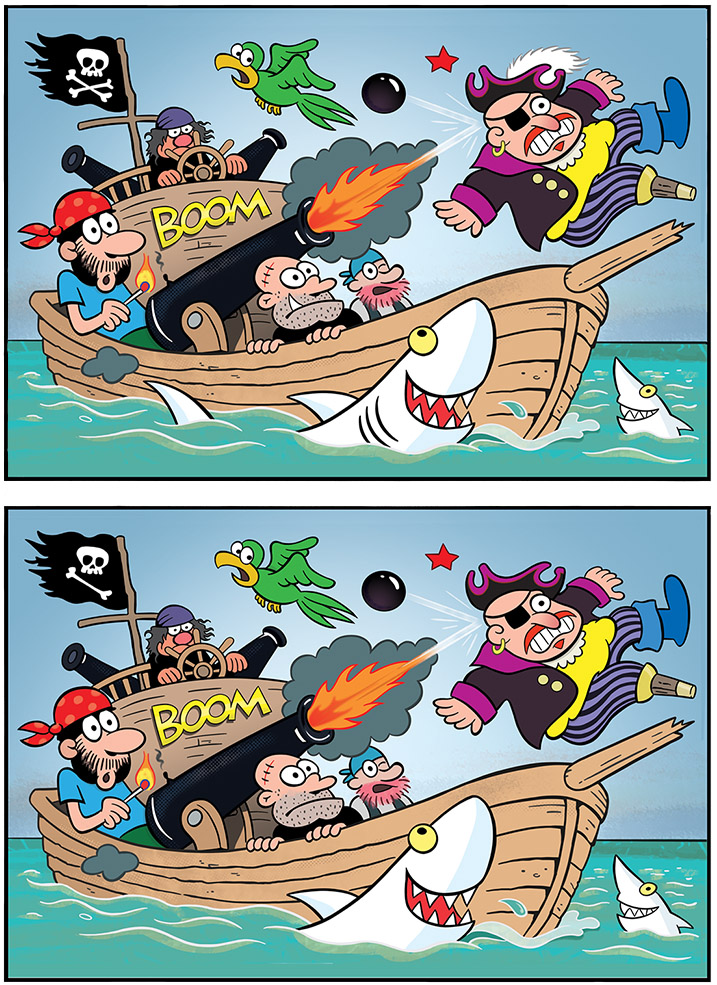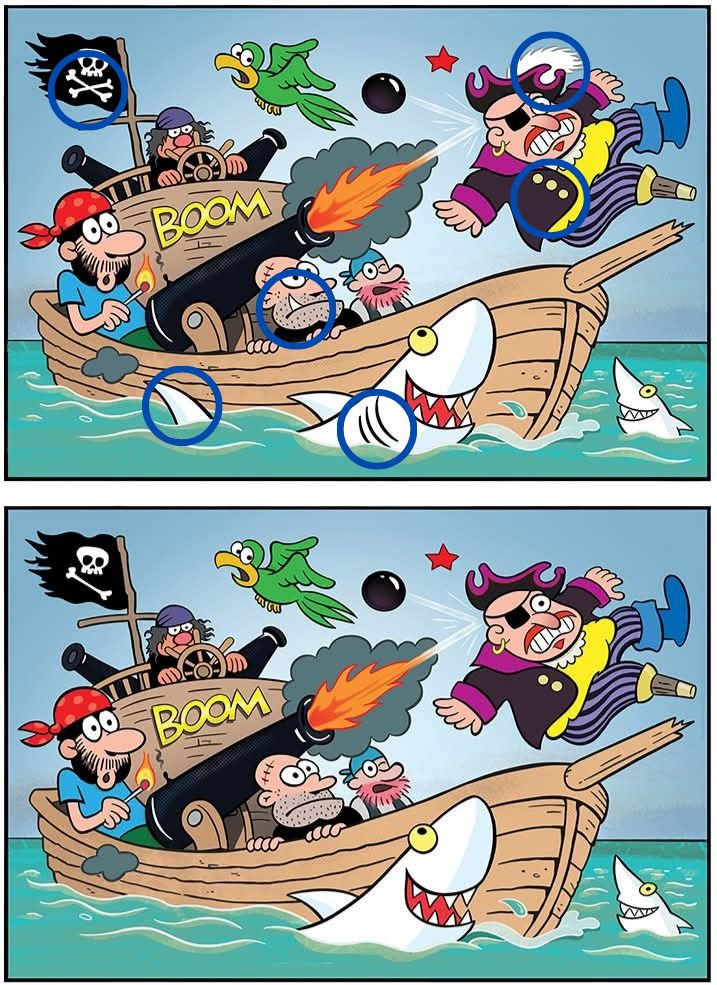When the roar of a cannon echoes across azure waters and a pirate’s figurehead sails into range, heart-pounding adventure awaits. In the lively illustration above, a ragtag crew huddles behind a blazing cannon—its muzzle flashing fire—while a rival buccaneer flies skyward and curious sharks circle below. Whether you’re a history buff fascinated by 18th-century naval warfare or simply love swashbuckling tales, this in-depth guide explores everything from cannon mechanics to crew coordination in the golden age of piracy.
The Anatomy of a Pirate Cannon: How These Behemoths Worked
Pirate ships packed surprisingly powerful artillery aboard cramped vessels. A typical naval cannon comprised:
- Barrel (Tube): Cast from bronze or iron, up to 8 feet long for heavy 24-pounders, its bore diameter defined the shot size.
- Trunnions: Side-mounted pivots resting in wooden carriage grooves, allowing elevation adjustment.
- Carriage: A sturdy oak frame on four small wheels (“trucks”) that absorbed recoil.
- Worm and Sponge: Tools for clearing debris and dampening embers between shots.
Understanding these parts illuminates how pirates achieved deadly accuracy—despite rolling decks and tight quarters.

Loading the Cannon: A Step-by-Step Crew Ballet
Firing a cannon wasn’t a one-man job. Pirate crews rehearsed a precise choreography:
- Swab the Bore: The sponge end of a wet rammer extinguished lingering sparks.
- Load Powder Charge: A measured cloth or paper cartridge containing gunpowder slid down the barrel.
- Ram Home the Wad: A wooden wad (often cloth-wrapped turf) sealed the charge.
- Insert Shot: A solid iron ball or canister shot loaded and rammed home.
- Prick and Prime: A metal pricker pierced the cartridge, then loose powder (“priming”) filled the vent hole atop the breech.
- Ignition: A slowmatch or linstock (lit fuse) touched off the priming, igniting the main charge.
Every step required timing and teamwork—one miscue could fizzle the shot or spark a premature explosion.
Aiming and Firing: Techniques for Hitting Your Mark
On a rolling deck, pirates combined experience, instinct, and crude sights carved into the barrel:
- Bracketing: Firing a test shot short, then one long and adjusting accordingly—much like zeroing a rifle.
- Elevation Control: Raising or lowering the trunnions, sometimes propping blocks under the carriage’s rear.
- Timing the Roll: Firing at the trough of the wave minimized vertical barrel movement, improving accuracy.
These tactics allowed our illustrated crew to send a rival captain flying—proof that practice and sea-legs beat raw muscle.

Choosing the Right Ammunition: From Round Shot to Chain Shot
Pirates wielded different shot types for varied effects:
- Round Shot: Solid cannonballs that smashed hulls or masts.
- Chain Shot: Two half-balls connected by chain segments; designed to shred sails and rigging, incapacitating a ship’s mobility.
- Grape and Canister: Bags of smaller iron balls or nails that turned the cannon into a giant shotgun, devastating enemy decks and personnel.
In our scene, the hefty round shot blasts home—but an expert crew might switch to chain shot if they aimed to disable the pirate vessel rather than sink it outright.
Avoiding Shark-Infested Waters: Seaborne Hazards Beyond Battle
While pirates dueled on deck, sharks prowled below. A splintered foe overboard became easy prey, and spillage of blood or gunpowder-tinged water could attract curious predators. Crews took precautions:
- Recovering Spent Cartridges Quickly to prevent debris from drawing fish and sharks close.
- Avoiding Excessive Bloodletting by cleaning wounds on deck rather than sloshing gore overboard.
- Maintaining Speed—gliding at full sail reduced vulnerable drift time.
In our illustration, two sharks circle the battered ship—reminding us that the ocean’s perils extended far beyond enemy fire.

Crew Coordination and Morale: Winning the Psychological War
Pirates thrived on fear and spectacle. A well-timed broadside could shatter enemy resolve before the powder even settled. Captains maintained morale through:
- Drunken Bravado: A shared tot of rum before battle steadied nerves and fostered camaraderie.
- Shanties and Chants: Rhythmic songs kept rowers or deckhands in sync and bolstered fighting spirit.
- Flag Displays: A black flag emblazoned with skull and crossbones signaled “no quarter”—often terrifying targets into quick surrender.
In our cartoon, the skull-flag flies as the crew holsters their fear in favor of ruthless efficiency, turning chaos into controlled power.
Rebellion and Reputation: Why Piracy Pulled So Many to the Sea
Beyond the mechanics of cannon and cutlass, piracy thrived on social dynamics:
- Democratic Crews: Many pirate ships operated on elected captains and quartermasters, dividing plunder evenly—a stark contrast to harsh naval discipline.
- Potential Riches: Lacking legal share limits, pirates split cargo and gold bullion generously, attracting sailors from merchant fleets.
- Adventure and Freedom: Sailing under no admiralty, pirates escaped rigid class systems, living by their own codes.
Our explosive encounter between rival pirates isn’t just a battle; it’s the clash of alternative lifestyles—one upholding commerce rules, the other smashing them.

Conclusion
The vivid tableau of a pirate ship’s cannon boom sending an enemy captain flying—and curious sharks circling—captures the heart of high-seas combat. From mastering the art of loading and aiming cannons amid rolling decks to choosing the perfect ammunition and coordinating a fearless crew, piracy fused technical skill with psychological warfare. By understanding these tactics and the wider context—shark hazards, democratic crewing, and the promise of untold riches—we gain fresh appreciation for the legends of the Golden Age. Next time you hear that thunderous “BOOM” echoing across the waves, remember: behind every burst of flame lies a story of craftsmanship, courage, and the chaotic freedom that lured so many to piracy’s perilous call.





